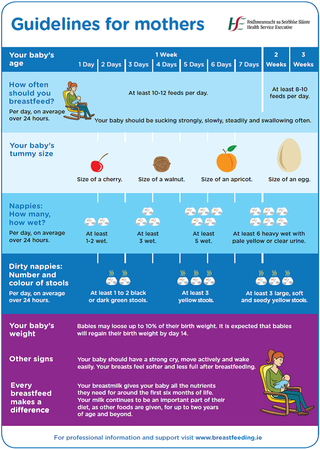Your baby's weight and their dirty nappies can help you tell if your newborn is getting enough breastmilk.
Nappies should be wet and dirty
Your baby should be producing wet and dirty nappies.
Your baby’s first dirty nappies are black and tarry. This is called meconium.
Over the next day or so, your baby’s poos become greenish in colour. By day 5, your baby will have yellow seedy poos.
Here's what you can expect from your baby's nappies per day:
Day 1
- 1 wet nappy (over 24 hours)
- 1 poo (black)
Day 2
- 2 wet nappies
- 2 poos (black)
Day 3
- 3 wet nappies
- 3 poos (black or green)
Day 4
- 4 wet nappies
- 3 to 4 poos (green or yellow)
Day 5
- 5 wet nappies
- poos should turn yellow
6 days to 6 weeks
- 6 wet nappies (heavy wet with pale, yellow or clear urine)
- 3 to 8 poos (yellow, seedy, runny to loose)
6 weeks to 6 months
- 3 to 5 poos daily, but may skip days (yellow, soft and may thicken over time because of milk composition changes)
Your newborn's feeding routine
Weight loss
All newborn babies lose weight in the first few days after birth. After this, they begin gaining weight.
By 2 weeks, most babies are back at their birth weight. But some may take 3 weeks.
You may need extra support from a lactation nurse or midwife if your baby's weight gain is slow.
Use the 'guidelines for mothers' chart
The following guidelines show how often your newborn baby may feed, and how many wet and dirty nappies to expect.

Signs your baby is feeding well
If your baby is feeding well, you should be able to see and hear them swallow.
You can also check for other signs your baby is feeding well.
During a feed your baby:
- starts with a few rapid sucks followed by long, rhythmic sucks and swallows with occasional pauses
- has rounded cheeks
- seems calm and relaxed
At the end of the feed, your baby:
- comes off the breast on their own
- has a wet mouth
- appears content and satisfied
After a feed:
- your breasts should feel softer
- your nipple should look more or less the same – not flattened, pinched or white
- you may feel sleepy and relaxed
Ways to ensure your supply is good
Do
-
encourage responsive feeding at the breast
-
offer both breasts at each feed and alternate which breast you start with
-
keep your baby close to you and encourage skin-to-skin contact as much as possible
Don't
-
do not give formula to your baby
-
do not use soothers in newborn babies
